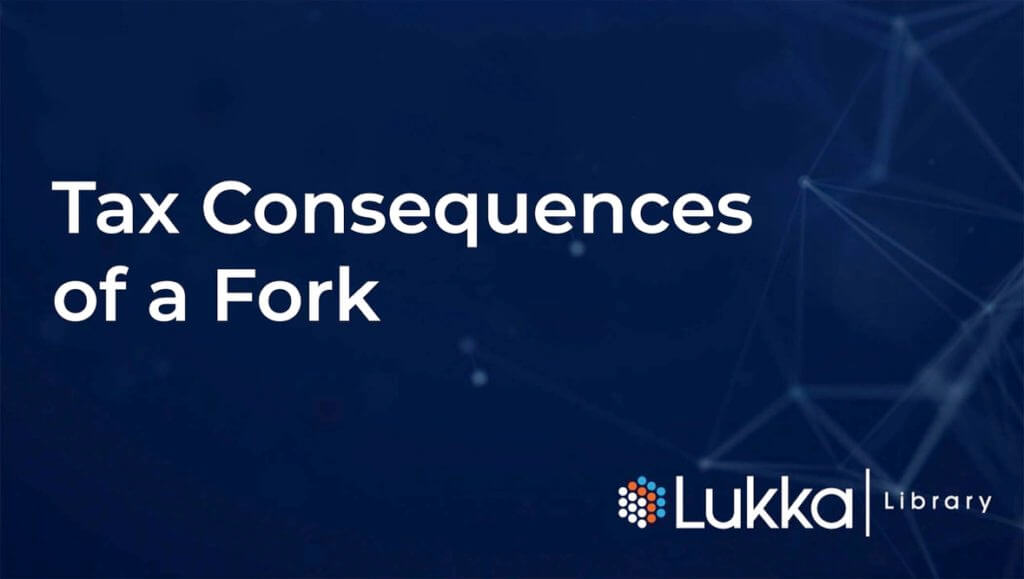
Authors: Mindy Herzfeld, Jon Holbrook, and Robert Daily, Ivins Phillips Barker Chartered1
The analysis in this memo reflects the law in existence as of February 11, 2020.
Summary
This paper discusses the tax consequences of soft and hard forks of cryptocurrency. Based on recent IRS guidance, a taxpayer who holds cryptocurrency does not realize income when the cryptocurrency goes through a software change (as described below) or a non-contentious hard fork but does realize income when the hard fork is followed by an airdrop. In its published guidance, the IRS did not address the tax consequences of a contentious hard fork.
Background- Blockchains
The system underlying a type of cryptocurrency records a notional piece of property (cryptocurrency, some of which are called tokens) on a distributed ledger (a blockchain), which is validated by computer network participants (nodes). Unlike fiat currency (e.g., the U.S. dollar, which is issued and backed by a central government), cryptocurrency is not issued or overseen by any central organization. Instead, the cryptocurrency is controlled by its protocol, which sets out the terms for the software (e.g., how a transaction will be verified by nodes, how many nodes are required to change the protocol, and how large a block in the blockchain can be). Each block in the blockchain is validated by the nodes, and once validated, attaches to the previous block. No one can change the block after it attaches to the blockchain.
Anyone is free to buy or sell a cryptocurrency or verify a transaction according to the protocol of that cryptocurrency. Additionally, many cryptocurrencies, like Bitcoin, are open source, meaning that the cryptocurrency protocol can be modified by anyone. This decentralization means that developers or nodes may disagree with each other and change the structure of the cryptocurrency by creating a fork in the software or a fork in the blockchain.
Forking Software (Soft Fork)
A fork in the software occurs when the core protocol of the cryptocurrency is modified. For example, suppose that the block size of Crypto A was 8MB when created but the nodes and developers of Crypto A all decide to decrease the blocksize to 1MB. When the block size decreases from 8MB to 1MB, a fork in the software occurs. The fork does not create a new blockchain, but it does create a new cryptocurrency and is backwards compatible (meaning that a participant who did not upgrade the cryptocurrency can still trade her cryptocurrency on the upgraded blockchain).
In Revenue Ruling 2019-24, the IRS addressed the tax consequences of two types of transactions involving cryptocurrency but did not directly address the tax consequences of a soft fork. In a series of FAQs released with that Revenue Ruling, the IRS described a “soft fork” as one that “occurs when a distributed ledger undergoes a protocol change that does not result in a diversion of the ledger and thus does not result in the creation of a new cryptocurrency.”2 The FAQ stated that because the cryptocurrency holder does not receive any “new” cryptocurrency as a result of the soft fork, the holder does not recognize any income.3
Forking Blockchain (Hard Forks)
A fork in the blockchain occurs when a certain number of nodes disagree on what block is the latest block in the blockchain. These forks are also known as “hard forks” and come in four different varieties.
Temporary Blockchain Fork
Because there is no “official” blockchain, it is possible to have two temporary blockchains if two miners complete blocks around the same time or if one miner fails to update its software after a change in a cryptocurrency’s protocol. This scenario, commonly known as a “temporary blockchain fork,” usually only lasts for one block. The nodes validating the cryptocurrency will recognize one block as the correct one and will continue the blockchain on that block. Because a temporary blockchain fork resolves itself quickly and does not create any new cryptocurrency, this type of hard fork may be most similar to the “soft fork” (fork in the software) described above. To the extent this type of fork is characterized as a soft fork, it may be a non-recognition event for tax purposes, with the tax consequences that follow from a non-recognition event (i.e., carryover basis and holding period).
Non-Contentious Hard Fork
A planned hard fork exists when developers of a cryptocurrency create a new chain or cryptocurrency from the underlying software of an old cryptocurrency. For example, developers could upgrade the security of a cryptocurrency and, fearing that the old chain is not as secure, create a new blockchain that is not backwards compatible (cryptocurrency that has not been upgraded would not be recognized by the new blockchain and would thus be unable to be traded on the blockchain). Although there are no new coins, the old chain would die and the tokens that have not been upgraded would not be accepted by the new blockchain.
A planned fork can also occur when cryptocurrency developers decide to make a new cryptocurrency (B) from an existing cryptocurrency (A). After the non-contentious hard fork, the developers may intend that the blockchain for cryptocurrency A will stop and the blockchain for cryptocurrency B will continue, meaning that cryptocurrency B will not be backwards compatible with cryptocurrency A. The IRS addressed this specific fact pattern in Rev. Rul. 2019-24 and ruled that under such facts, a cryptocurrency holder does not have gross income presumably because the IRS felt that the holder “does not receive units of a new cryptocurrency.” The IRS reiterated in its FAQ that if a holder’s “cryptocurrency went through a hard fork, but [the holder] did not receive any new cryptocurrency,” then the holder doesn’t “have taxable income.”4 Although not completely clear, the IRS apparently views a transaction in which a cryptocurrency is created from a cryptocurrency that expires as part of the same transaction as not resulting in a “new” cryptocurrency.” Based on the IRS’s reasoning in its revenue ruling and its guidance in the FAQ, an argument could be made that provided that new cryptocurrency B has the same rights and obligations as cryptocurrency A, the creation of cryptocurrency B is a non-recognition event with the attendant tax consequences.
Hard Fork followed by an Airdrop
Revenue Ruling 2019-24 also addressed the tax consequences when an “airdrop” (which the IRS described as “a means of distributing units of a cryptocurrency to the distributed ledger addresses of multiple addresses”) follows a hard fork.5 The IRS said that a “hard fork followed by an airdrop results in the distribution of units of the new cryptocurrency to addresses containing the legacy cryptocurrency.”
The IRS ruled that a cryptocurrency holder who receives an airdrop of new cryptocurrency recognizes gross income because the holder has an accession to wealth (i.e., the holder has received a notional piece of property over which the holder has dominion and control6) at the time that the new cryptocurrency is recorded on the new ledger.7 The IRS explained in its FAQ that a taxpayer recognizes this income in the year in which the holder “has dominion and control over the cryptocurrency so that you can transfer, sell, exchange, or otherwise dispose of the cryptocurrency.”8 The IRS also noted (a) the amount of income that the holder recognizes is equal to the fair market value of the airdropped cryptocurrency (e.g., Crypto B in the diagram above)9; (b) the character of this income is ordinary10; and (c) the taxpayer takes a tax basis in the airdropped cryptocurrency equal to income recognized.11
There are two reasons why the IRS position on this issue may be questioned. First, to the extent that the stream of payments from a hard fork cannot be fully determined, the hard fork may be accounted for under the “open transaction” doctrine, under which a taxpayer should not report gain until the transaction is considered closed.12 (Note that the IRS will likely disagree with this characterization because the agency asserts that the open transaction doctrine applies only in “rare and extraordinary cases.”13) Second, taxpayers might want to argue (contrary to the IRS’s position that a hard fork is not a “sale or exchange” under section 1223) that the character of any income realized in a hard fork is capital, on the grounds that a hard fork is considered an “other termination” of a right “with respect to” a cryptocurrency under section 1234A.
Contentious Hard Fork
A contentious hard fork occurs when there is a faction within the cryptocurrency whereby two groups decide to split off, either because developers within the community disagree about certain technical aspects or because some members want to start an entirely new cryptocurrency by leveraging the recognition of an existing cryptocurrency. Although some contentious hard forks create new cryptocurrencies that are worthless, some contentious hard forks have created well known and valuable altcoins (e.g., Bitcoin and Bitcoin Cash). For example, assume there is a contentious hard fork within Crypto A that results in Crypto A and Crypto B. The past transactions of Crypto A, prior to the hard fork, are recognized by Crypto B. Therefore, right after the hard fork, any holder that owns Crypto A receives an amount of Crypto B that equals its amount in Crypto A.
The contentious hard fork is analytically different from an “airdrop” and was not discussed in Rev. Rul. 2019-24. However, the FAQ said that a holder does not have income if she “did not receive any new cryptocurrency, whether through an airdrop…or some other kind of transfer.”14 The implication of this statement may be that the tax consequences of a hard fork followed by an airdrop are similar to those resulting from the transaction in which a taxpayer receives a new type of cryptocurrency as a result of a contentious hard fork. Under this interpretation, a cryptocurrency holder may have gross income if the taxpayer has “dominion and control” over the cryptocurrency asset that was created as a result of the contentious hard fork.15
Nevertheless, the IRS guidance has not directly addressed the tax treatment of a contentious hard fork, and there are other possible ways to characterize the contentious hard fork for tax purposes. For example, a hard fork could be analogized to a stock dividend (a non-recognition event whereby property rights are split but no sale or exchange has occurred),16 a birth of a calf (a non-recognition event whereby the holder has no basis in the new cryptocurrency like a calf-breeder has no basis in the newly born calf 17), or a home run ball (found property that is not taxable income).18
1 This material was produced for the Lukka library. This paper is not intended to be, nor should it be constructed as constituting, legal or tax advice provided by Ivins, Phillips & Barker, Chartered. Unless otherwise indicated, all “section” or “§” references are to the Internal Revenue Code of 1986, as amended, and all “Treas. Reg. §” references are to the Treasury regulations promulgated thereunder.
2 A common way to distinguish between a soft fork (fork in the software) and a hard fork (fork in the blockchain) is based on whether the fork is backwards compatible, meaning that a new version of the cryptocurrency can be used by an older version of the cryptocurrency that hasn’t been upgraded.
3 IRS, Frequently Asked Questions on Virtual Currency Transactions, FAQ #29 https://www.irs.gov/individuals/international-taxpayers/frequently asked-questions-on-virtual-currency-transactions (last accessed January 17, 2020). Query whether a protocol change may be so substantial that a holder actually receives “new” property that is unlike the “old” protocol change. See, e.g., Cottage Savings Association v. Commissioner, 499 U.S. 554, 565 (1991) (holding that there is a sale or disposition of property under section 1001 when a taxpayer disposes of property that is “different” because the taxpayer “enjoy[s] legal entitlements that are different in kind or extent.”).
4 IRS, Frequently Asked Questions on Virtual Currency Transactions, FAQ #21.
5 Many cryptocurrency community experts believe that an airdrop after a fork is not common (and certainty are not as common as contentious hard forks). See Peter Van Valkenburgh, IRS Cryptocurrency guidance answers some questions while raising messy new ones, CoinCenter (Oct. 9, 2019) (https://coincenter.org/entry/irs-cryptocurrency-guidance-answers-some-questions-while-raising-messy-new-ones). It is possible that the IRS conflated the term “airdrop” with “contentious hard fork” or that the IRS uses a different definition from that which is commonly accepted by the cryptocurrency community.
6 One important unanswered tax question is whether a holder who cannot immediately trade the airdropped cryptocurrency without upgrading the protocol (which the holder may be loath to upgrade for fear of a so-called “replay” attack) has dominion and control over the airdropped cryptocurrency. A similar question exists with taxpayers who receive airdrops on exchanges that don’t support the currency that was airdropped because the holder would be unable to trade the cryptocurrency without moving the newly airdropped cryptocurrency out of the holder’s current crypto wallet. The IRS said in FAQ#24 that a holder recognizes income as a result of a hard fork “when [the cryptocurrency] is received, which is when the transaction is recorded on the distributed ledger, provided that you have dominion and control over the cryptocurrency so that you can transfer, sell, or otherwise dispose of the cryptocurrency.” Query whether a person has dominion and control if the person could but decides not to upgrade the software and therefore does not have the ability to transfer the new unit of cryptocurrency.
7 See I.R.C. § 61.
8 IRS, Frequently Asked Questions on Virtual Currency Transactions, FAQ #23. Query whether the open transaction doctrine does or should apply to this type of transaction, and to what extent Treas. Reg. § 15a.453-1(d) may limit application of the open transaction doctrine.
9 IRS, Frequently Asked Questions on Virtual Currency Transactions, FAQ #23, 25.
10 Id., FAQ #23, 41.
11 Id, FAQ #24.
12 See Burnet v. Logan, 283 U.S. 404 (1931); Eric D. Chason, Cryptocurrency Hard Forks and Revenue Ruling 2019-24, 39 Va. Tax R. 277, 283 (2019); N.Y. STATE BAR ASS’N, REPORT NO. 1433 – REPORT ON THE TAXATION OF CRYPTOCURRENCY 17–18 (2020), https://nysba.org/app/uploads/2020/03/Report 1433.pdf.
13 Treas. Reg. § 15a.453-1(d).
14 Id., FAQ #21.
15 See also Treas. Reg. § 1.61-14(a) (listing the tax consequences of Treasure Trove and found property).
16 See, e.g., Eisner v. Macomber, 252 U.S. 189 (1920). If the contentious hard fork was not a taxable event, the taxpayer would need to allocate basis
of the original cryptocurrency (e.g., Crypto A) between the original cryptocurrency (e.g., Crypto A) and the newly created cryptocurrency (e.g., Crypto B) after the contentious hard fork.
17 See Gamble v. Commissioner, 68 T.C. 800 (1977); Rev. Rul. 86-24, 1986-1 C.B. 80.
18 See IR-98-56, https://www.irs.gov/pub/irs-news/ir-98-56.pdf.



